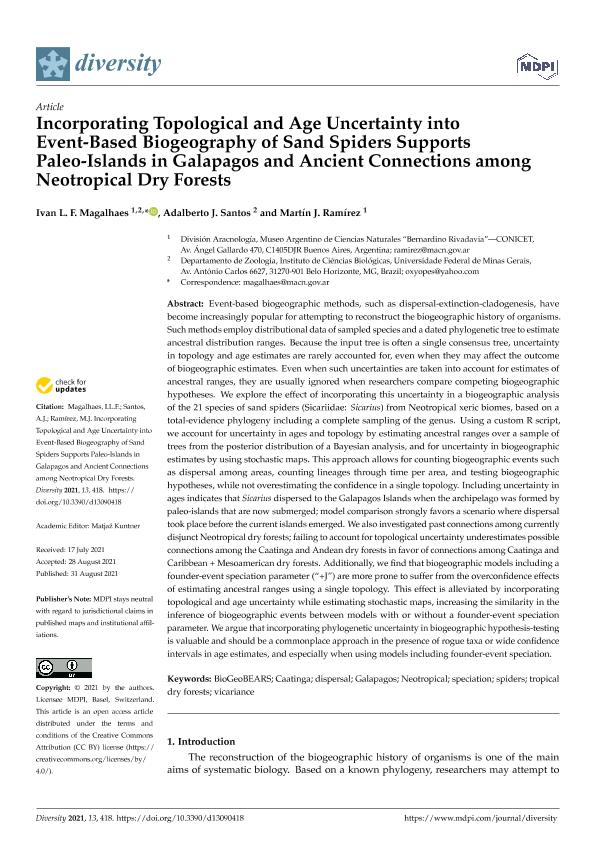Artículo
Incorporating topological and age uncertainty into event-based biogeography of sand spiders supports paleo-islands in galapagos and ancient connections among neotropical dry forests
Fecha de publicación:
08/2021
Editorial:
MDPI
Revista:
Diversity
ISSN:
1424-2818
Idioma:
Inglés
Tipo de recurso:
Artículo publicado
Clasificación temática:
Resumen
Event-based biogeographic methods, such as dispersal-extinction-cladogenesis, have become increasingly popular for attempting to reconstruct the biogeographic history of organisms. Such methods employ distributional data of sampled species and a dated phylogenetic tree to estimate ancestral distribution ranges. Because the input tree is often a single consensus tree, uncertainty in topology and age estimates are rarely accounted for, even when they may affect the outcome of biogeographic estimates. Even when such uncertainties are taken into account for estimates of ancestral ranges, they are usually ignored when researchers compare competing biogeographic hypotheses. We explore the effect of incorporating this uncertainty in a biogeographic analysis of the 21 species of sand spiders (Sicariidae: Sicarius) from Neotropical xeric biomes, based on a total-evidence phylogeny including a complete sampling of the genus. Using a custom R script, we account for uncertainty in ages and topology by estimating ancestral ranges over a sample of trees from the posterior distribution of a Bayesian analysis, and for uncertainty in biogeographic estimates by using stochastic maps. This approach allows for counting biogeographic events such as dispersal among areas, counting lineages through time per area, and testing biogeographic hypotheses, while not overestimating the confidence in a single topology. Including uncertainty in ages indicates that Sicarius dispersed to the Galapagos Islands when the archipelago was formed by paleo-islands that are now submerged; model comparison strongly favors a scenario where dispersal took place before the current islands emerged. We also investigated past connections among currently disjunct Neotropical dry forests; failing to account for topological uncertainty underestimates possible connections among the Caatinga and Andean dry forests in favor of connections among Caatinga and Caribbean + Mesoamerican dry forests. Additionally, we find that biogeographic models including a founder-event speciation parameter (“+J”) are more prone to suffer from the overconfidence effects of estimating ancestral ranges using a single topology. This effect is alleviated by incorporating topological and age uncertainty while estimating stochastic maps, increasing the similarity in the inference of biogeographic events between models with or without a founder-event speciation parameter. We argue that incorporating phylogenetic uncertainty in biogeographic hypothesis-testing is valuable and should be a commonplace approach in the presence of rogue taxa or wide confidence intervals in age estimates, and especially when using models including founder-event speciation.
Archivos asociados
Licencia
Identificadores
Colecciones
Articulos(MACNBR)
Articulos de MUSEO ARG.DE CS.NAT "BERNARDINO RIVADAVIA"
Articulos de MUSEO ARG.DE CS.NAT "BERNARDINO RIVADAVIA"
Citación
Fiorini de Magalhaes, Ivan Luiz; Santos, Adalberto J.; Ramirez, Martin Javier; Incorporating topological and age uncertainty into event-based biogeography of sand spiders supports paleo-islands in galapagos and ancient connections among neotropical dry forests; MDPI; Diversity; 13; 9; 8-2021; 1-23
Compartir
Altmétricas




